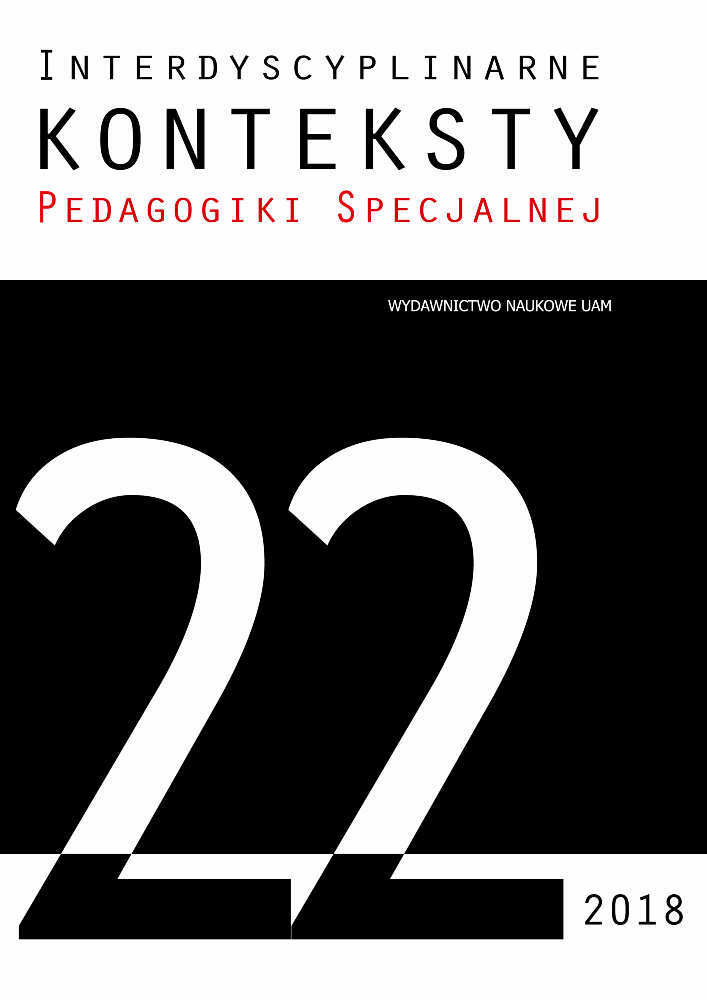Abstrakt
Joanna Gładyszewska-Cylulko, Self-stigma in the visually impaired, Interdisciplinary Contexts of Special Pedagogy, No. 22, Poznań 2018. Pp. 179–193. Adam Mickiewicz University Press. ISSN 2300-391X. DOI: https://doi.org/10.14746/ikps.2018.22.11
The blind and visually impaired are one of the groups prone to stigma. Stigma imposed by social environment may lead to self-stigma, that is expressing negative opinions about oneself as a result of the carried sigma. Self-stigma usually develops in three stages: first the stigmatised person realizes that they have been stereotyped, then they accept the stereotype and finally apply it to themselves. Thus, to develop selfstigma, the person has to be aware that they are perceived by the society in a stereotypical way (a blind person is usually perceived as passive, dependent and reliant on other people’s help), accept it and acknowledge themselves that this is their real image. Not every visually impaired person is will develop self-stigma. The article presents selected factors and preventive measures that may reduce the risk of self-stigma.
Bibliografia
Crocker J., Major B., Social Stigma and Self-Esteem: The Self-Protective Properties of Stigma, “Psychological Review” 1989, no. 96(4), pp. 608–630.
Corrigan P., Watson A., Understanding the impact of stigma on people with mental illness, “World Psychiatry” 2002, no. 1(1), pp. 16–20.
Czykwin E., Stygmat społeczny, PWN, Warsaw, 2007.
Gładyszewska-Cylulko J., Obraz osoby niepełnosprawnej wzrokowo w oczach pełnosprawnego społeczeństwa w kontekście przemian kulturowo-społecznych, „Wychowanie na co Dzień” 2013, no. 12, pp. 9–13.
Gładyszewska-Cylulko J., Postrzeganie możliwości i potrzeb osób niewidomych w Polsce i Australii, „Niepełnosprawność. Dyskursy pedagogiki specjalnej” 2017, no. 26, pp. 29–43.
Goffman E., Piętno. Rozważania o zranionej tożsamości, translated by A. Dzierżyńska, J. Tokarska-Bakir, GWP, Gdańsk 2005.
Jackowska E., Stygmatyzacja i wykluczenie społeczne osób chorujących na schizofrenię – przegląd badań i mechanizmy psychologiczne, „Psychiatria Polska” 2009, no. 6, pp. 655–670.
Kudlińska I., Stygmatyzacja społeczna jako perspektywa teoretyczno-badawcza (na przykładzie badań nad stygmatyzacją ludzi biednych), “Acta Universitatis Lodziensis Folia Sociologica” 2011, no. 38, pp. 51–72.
Link B. et al., The Consequences of Stigma for the Self-Esteem of People With Mental Illnesses, “Psychiatric Services” 2001, no. 52(12), pp. 1621–1626.
Majewski T., Psychologia niewidomych i niedowidzących, PWN, Warsaw 1983.
Ossowski R., Teoretyczne i praktyczne podstawy rehabilitacji, Wydawnictwo Uczelniane WSP, Bydgoszcz 1999.
Palak Z., Obraz własnej osoby młodzieży niewidomej, UMCS, Lublin 1988.
Pervin L.A., Psychologia osobowości, translated by M. Orski, GWP, Gdańsk 2005.
Podogrodzka-Niell M., Tyszkowska M., Stygmatyzacja na drodze zdrowienia w chorobach psychicznych – czynniki związane z funkcjonowaniem społecznym, „Psychiatr. Pol.” 2014, no. 48(6), pp. 1201–1211.
Watson A. et al., Self-Stigma in People With Mental Illness, “Schizophr Bull.” 2007, no. 33(6), pp. 1312–1318.
Zaorska M., Poczucie „Inności” u osób niewidomych i osób z resztkami wzroku w sferze funkcjonowania psychicznego, fizycznego i emocjonalnego, „Interdyscyplinarne konteksty pedagogiki specjalnej” 2013, no. 1, pp. 37–59.
